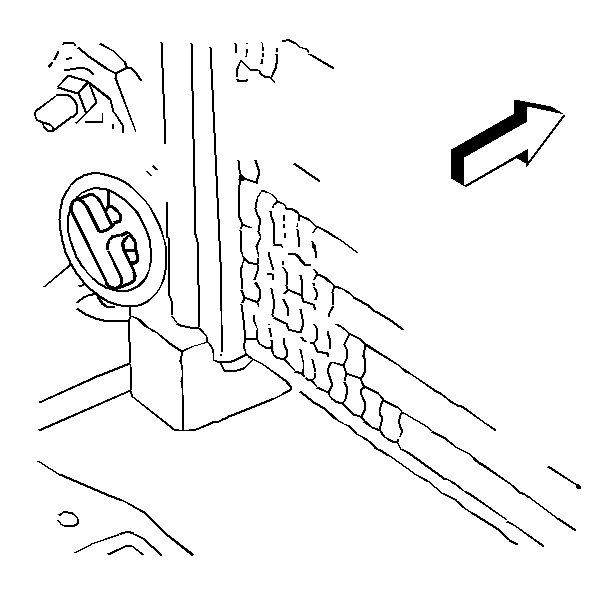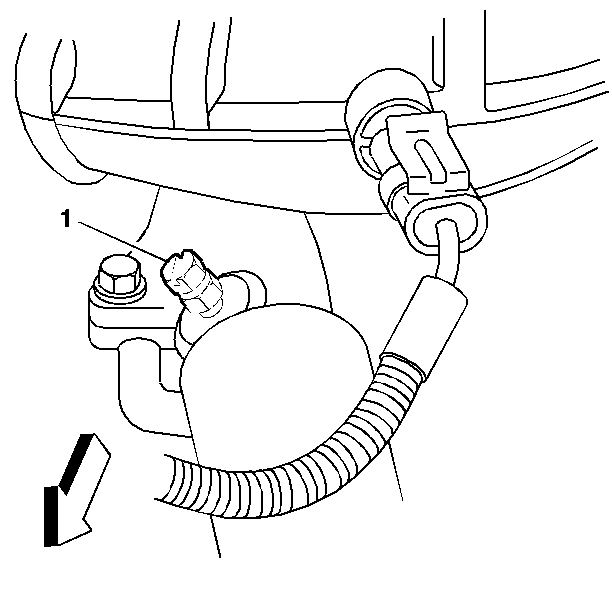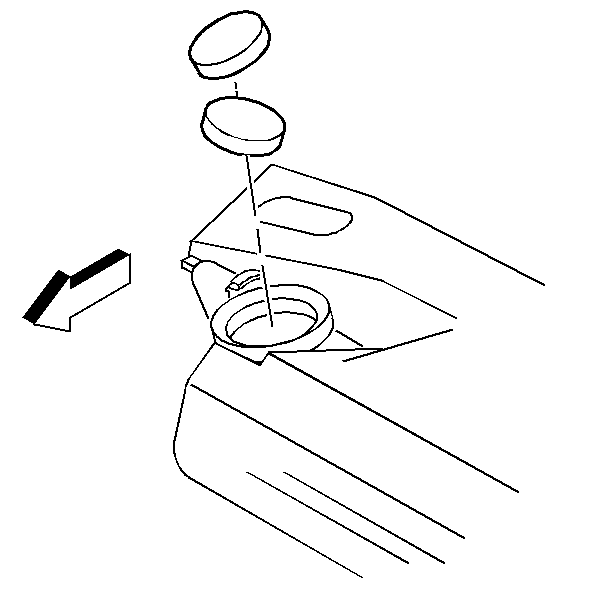Draining Procedure
Every 5 years or 166,000 km (100,000 mi), whichever occurs first, drain and fill the cooling system using the following recommended procedures:
- Park the vehicle on a level surface.
- Remove the coolant recovery reservoir filler cap. Refer to Coolant Recovery System .
- Open the radiator drain cock in the right-hand radiator end tank.
- Disconnect the negative battery cable. Refer to
Caution: Unless directed otherwise, the ignition and start switch must be in the OFF or LOCK position, and all electrical loads must be OFF before servicing any electrical component. Disconnect the negative battery cable to prevent an electrical spark should a tool or equipment come in contact with an exposed electrical terminal. Failure to follow these precautions may result in personal injury and/or damage to the vehicle or its components.
in General Information. - Open the heater air bleed valve (1), just above the water pump, on the water pump inlet. Place a shop towel underneath the bleed valve in order to prevent the coolant from splashing onto the distributor.
- Remove both of the electronic spark control knock sensors on both sides of the engine block.
- Allow the system to completely drain.
Notice: When adding coolant, it is important that you use GM Goodwrench DEX-COOL™ coolant. If coolant other than DEX-COOL™ is added to the system, the engine coolant will require change sooner: at 50 000 km (30,000 miles) or 24 months.
Caution: Do not remove the coolant recovery reservoir cap while the cooling system is hot. Serious personal injury may result. Only remove the cap from a cool engine.



Notice: Dispose of used engine coolant in the proper manner, such as in a used engine coolant holding tank. DO NOT POUR USED ENGINE COOLANT DOWN A DRAIN! Ethylene glycol antifreeze is a very toxic chemical. Do not dispose of coolant into the sewer system or ground water. This is illegal and ecologically unsound.
Engine Coolant Recycling
Tools Required
GM approved Recycling System such as Pro Clean (Available in the GM Dealer Equipment Program)
Whenever the cooling system needs maintenance or repairs, remove and replace the coolant with qualified new or recycled coolant.
If you only drain the radiator, up to 50 percent of the used, contaminated coolant can remain in the cooling system.
Use any of the following methods in order to remove the coolant:
| • | Use a waterless coolant evacuation system, available in the GM Dealer Equipment program, or equivalent, that removes the used coolant and replaces the coolant with new or recycled coolant. |
| • | Use a GM approved coolant recycling system, available in the GM Dealer Equipment program, or equivalent, that recycles the coolant on the vehicle. This eliminates the need for coolant evacuation. |
| Important: Do not recycle coolant on vehicles manufactured with GM Goodwrench Dex-Cool. |
| • | Recover the used coolant. Store the coolant in a used coolant holding tank. Submit the used coolant for recycling on a regular basis. |
Filling Procedure
- Close the radiator drain cock.
- Install the electronic spark control knock sensors on both sides of the engine block.
- Fill the cooling system, to the FULL COLD mark, through the coolant recovery reservoir.
- When the bubbles disappear and only the coolant is visible, close the heater air bleed valve.
- Connect the negative battery cable.
- Block the wheels.
- Place the transmission in PARK or NEUTRAL.
- Set the parking brake.
- Run the engine with the coolant recovery reservoir filler cap off, until the thermostat opens.
- Open the heater air bleed valve.
- When the bubbles disappear and only the coolant is visible, close the heater air bleed valve. Place a shop towel underneath the bleed valve in order to prevent the coolant from splashing onto the distributor.
- Fill the cooling system, through the coolant recovery reservoir, until the coolant level is approximately 25 mm (1 in) above the FULL COLD mark.
- Install the coolant recovery reservoir filler cap.
- After the engine reaches normal operating temperature, check the system for coolant leaks.
- Test the coolant concentration. Refer to Coolant Concentration Testing .


Tighten
Tighten the electronic spark control knock sensors to 19 N·m
(14 lb ft).
Notice: Use the correct fastener in the correct location. Replacement fasteners must be the correct part number for that application. Fasteners requiring replacement or fasteners requiring the use of thread locking compound or sealant are identified in the service procedure. Do not use paints, lubricants, or corrosion inhibitors on fasteners or fastener joint surfaces unless specified. These coatings affect fastener torque and joint clamping force and may damage the fastener. Use the correct tightening sequence and specifications when installing fasteners in order to avoid damage to parts and systems.
Notice: Pure coolant can be added to raise the boiling point of the coolant, but too much will affect the freezing point. Do not use a solution stronger than 70 percent, as the freeze level rises rapidly after this point. Pure coolant will freeze at -22°C (-8°F).

Tighten
Tighten the negative battery cable bolt to 17 N·m (13 lb ft).
Notice: Use the correct fastener in the correct location. Replacement fasteners must be the correct part number for that application. Fasteners requiring replacement or fasteners requiring the use of thread locking compound or sealant are identified in the service procedure. Do not use paints, lubricants, or corrosion inhibitors on fasteners or fastener joint surfaces unless specified. These coatings affect fastener torque and joint clamping force and may damage the fastener. Use the correct tightening sequence and specifications when installing fasteners in order to avoid damage to parts and systems.
Important:
Caution: Under some conditions, the ethylene glycol engine coolant is combustible. In order to help avoid being burned, do not spill the antifreeze or the coolant on the exhaust system or the hot engine parts.

Notice: Pure coolant can be added to raise the boiling point of the coolant, but too much will affect the freezing point. Do not use a solution stronger than 70 percent, as the freeze level rises rapidly after this point. Pure coolant will freeze at -22°C (-8°F).
Important: When refilling the cooling system, add 2 engine coolant supplement sealant pellets, GM P/N/ 3634621 or equivalent.
Notice: The Low Coolant warning/indicator lamp may come on after this procedure. If after operating the vehicle so that the engine heats up and cools down three times, the Low Coolant warning/indicator lamp does not go out, or fails to come on at the ignition check, and the coolant is above the full cold mark in the reservoir, refer to Low Coolant Warning/Indicator Lamp in Electrical Diagnosis. If at any time the Temperature warning/indicator lamp comes on, immediate action is required. Turn OFF the engine and allow the vehicle to cool. Do not remove the coolant recovery reservoir cap at this time.
